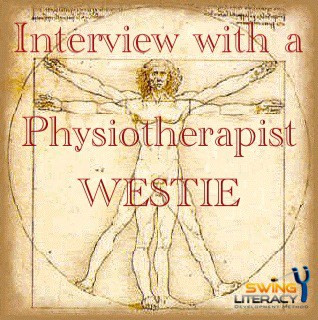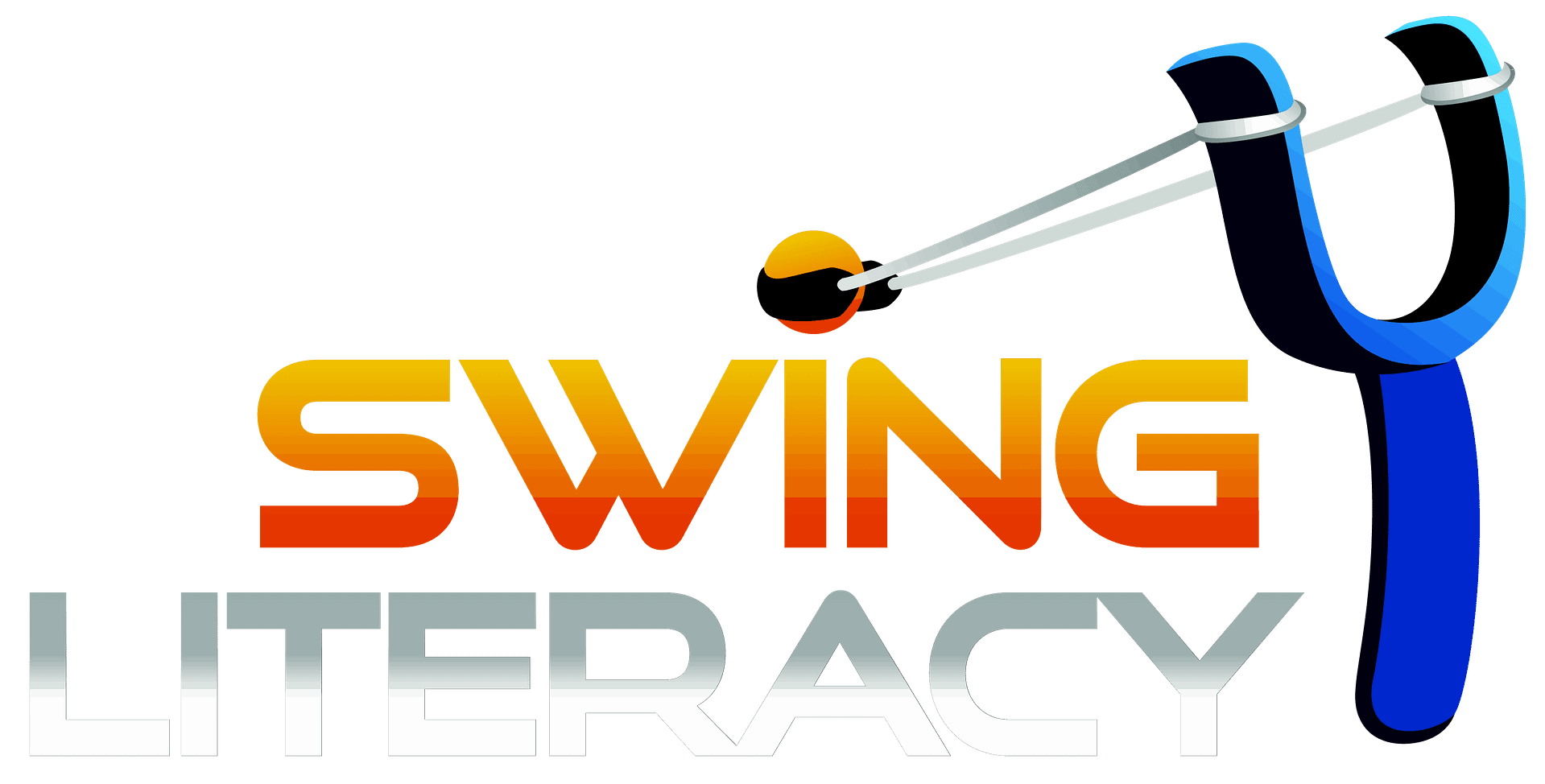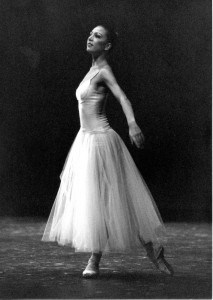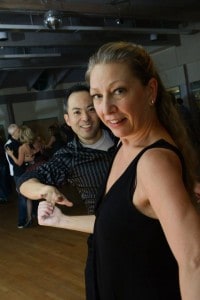No products in the cart.

Interview with a Physiotherapist Westie
Reading Time: minutes remaining
Ever wondered what physiotherapist’s take on West Coast Swing would be? It’s not easy to find one that really understands the nature of social dancing and the specific actions involved in WCS. But we’ve got one! Meet Ruth Norgaard, our WCS student for the past 3 years, who treats us when we are broken. We asked Ruth some questions about common WCS errors that lead to injury and how to avoid them. It was such a great resource, this interview is now also a chapter in one of the lessons in our Swing Literacy Development Method teacher training program.

Please note this is a long article, and it is not intended to be prescriptive nor instructional. For personal treatment advice, please visit your health practitioner. For instruction, please refer to the SLDM.
M&T: Let’s start by getting to know you. What is your profession and background?
Ruth: I am a Physiotherapist in private practice in Vancouver BC, I obtained my BScPT from the University of British Columbia in 2004 and then pursued post graduate studies in manual therapy from the Canadian Physiotherapy Association, Mulligan and Mckenzie techniques, Neurodynamic approaches and the Integrated Systems Approach (Lee & Lee) and Thoracic Ring Series “Connect Therapy” Part 4 TM (LjLee.). I don’t think the list will ever end! Like dance, Physiotherapy is a life long journey.
Prior to Physiotherapy I was a professional ballet dancer. I had my first professional contract with Santa Barbara Ballet, then moved to Seattle for intensive training with First Chamber Dance Company and Pacific Northwest Ballet, then moved back to Canada and joined Les Grands Ballets Canadiens in Montreal Quebec. I also worked with Ballet Ouest and did television and theatre productions. While my primary technique was ballet, my movement and the demands upon me were from classic jazz, contemporary “modern” or “lyrical”, tap, flamenco, ballroom and latin movement. Part of my career was also as a rehearsal director, coach and teacher.

Describe your WCS experience?
I had stopped dancing for close to a decade for many reasons (education, injury etc.) and then returned, at first to ballroom classes, it was fun but…when I found West Coast Swing I fell in love with it. I started with one studio but then made a conscious decision to embrace as many resources as I could. I am so glad I did!
A bicycle injury in 2004 left me with a with a spinal cord injury, nerve damage of my lumbar spine and a myriad of other dysfunctions that I am still working on. I cannot express my thanks enough to my Physiotherapist!! I am finding my body again through physiotherapy and dance. It is a humbling yet fulfilling experience.
I have to admit there were a few injuries sustained in my return to dance that I cannot attribute to the bicycle injury. Social dancing is just that, no harm right? Not so, dancing that involves another person also carries the responsibility of being mindful of the person on the end of your arm. On two occasions I have seriously considered quitting social dancing because of dangerous and impactful dances.
My current game plan….I take lessons and consciously try to apply what I have learned in my dance. I stretch and practice some yoga, pilates, ballet inspired movements to grow and maintain my physical vocabulary as often as my schedule will allow. The gym, walking, tennis and swimming – cross training and eating healthy also helps! AND …I go to the health care provider who supports and makes a positive difference to my physical experience!!…in my case a Physiotherapist. I also pace myself at dances, while I appreciate a goofy fun late night dance, I know my limits.
I usually dance around 3 or 4 times a week. I have a healthy balance of learning: My private lessons are ongoing depending on my and my pro’s schedules,

I take advantage of visiting professional’s workshops, some privates or workshops at conventions, attend conventions when I can afford it. I am now an Intermediate WCS dancer averaging 4 -5 conventions a year. I also compete in Masters where I can tell you I have had fantastic experiences!
In the big picture, what types of injuries are WCS dancers prone to?
In my experience, WCS dancers tend to have wrist tendonitis or tendonopathies (incorrect grip and arm tension), shoulder strains of the biceps or rotator cuff (unexpected weight support moves, “cranking” through turns, flaccid frame), knee strains or meniscal injuries (twisting in sticky shoes, squatting for dips), ankle strains (these can be serious and take months to years to recover), foot problems such as Morton’s neuromas (way too much pounding of feet without strengthening), plantar fasciaitis, hallux valgus- big toe going sideways!! (these can be painfree or require surgery), males tend to have more back injuries (often poor posture), and women can easily aggravate their hips (hitting too hard!!) I know there is a longer list and perhaps some thoracic drivers in there…I could go on…
But whole system is intensely integrated, isn’t it? One incorrect alignment can have a ripple effect on several joints.
Absolutely!!! You think it’s just your ankle? Hah! Think of how much you have done to your body in your life besides dance. Car accident? Trip on the stairs? Slam into a snow bank? Sit like a pretzel for 20 years? Martial arts, gym, hike, swim? Awkward body positions repetitively?
Just because it doesn’t hurt doesn’t make it healthy or fully functional! Ask yourself why you can turn to the right but not the left? That list goes on and on. If you imagine a puppet with clear strings, it moves freely, now twist the strings. Doesn’t work so well: the human body is not that different. The body is fabulously integrated and is capable of beautiful things like dancing. You need all of you, so take care of it.
Many of the fundamental movement techniques recommended in our Swing Literacy Development Method are designed to establish proper alignment and function right from day 1. Unfortunately, many are either misunderstood by students, or are either neglected or recklessly taught by teachers. Can we tackle some of these?
You are right, it takes people a while to embrace the simple yet crucial details of dancing, IF they ever do. Everyone wants to rush through their beginner phase because it seems so simple and they think, “I’ve got it”. Being introduced to something is a far cry from integrating it, which is a far cry from mastering it. Here’s a few of my notes on these massive topics.
The following commentary is not intended to be instructional. For actual comprehensive instructions on how best to learn, develop, and teach these skills, please refer to the Swing Literacy Development Method materials.
Posture
This is a huge concept very often poorly described and I suspect this is why many give up on it, as the application of the description is onerous.
I am going to use a couple of technical terms and then try to make it easier.
When static (not moving), your sternum (breast bone) should be in line with your pubic symphyisis (crotch bone). I like people to think of lifting the sternum as if to show off your favourite necklace. What I don’t agree with is the abused phrase, “squeeze your lats”: pinching your shoulder blades together and pulling them down, guaranteed issues further down the line if it becomes a habit. This locks down the shoulder girdle on the thorax preventing dissociation of the upper extremities (arms) from the body and therefore interrupting the flow we all strive for. Posture is a lengthy topic and because we all may need different cues or perhaps treatment to achieve good posture it can be a challenge for the dancer and for the dance teacher. Unless they are Physiotherapists or other accredited health professionals, dance teachers cannot offer treatment. They can guide and give cues, but the decision and responsibility to find treatment lays with the student or dancer. There may be an injury or muscle imbalance that prevents the attainment of a nice posture. Try changing your cues and sharing ideas with others, if someone has a fabulous posture, study it.
Frame
In my Ballroom and WCS experience, I have heard some dance teachers misguidedly teach that “frame” is a rigid position, involving “pulling down the lats”, to be maintained at all times. This is not only inaccurate, it’s counterproductive and can be dangerous. It’s simply not functional for WCS. Being rigid is counterintuitive to WCS’s elasticity, which means frame is only really used for steering. But even steering frame needs to be adaptable.
Appropriate physical freedom within posture make for a happy body and a happier dancer. Frame, is not rigid but held with awareness and has the ability to adapt and change in response to the demands of the dance. Adaptation skills are GOLD! Adaptation also means moving in and out of “states of rigidity” there are instances that accessing a more rigid core or frame is of value, single foot spins, drops, lifts are examples.
It is not that the “lats” or latissimus dorsi muscles aren’t engaged in obtaining frame but they do not work in isolation, and they certainly aren’t the star of the frame show! Steering involves the integration of other trunk core musculature and the rotator cuff tissues (the core of your shoulder). But in contrast, to be technical, the “lats” take the humerus (upper arm bone), and extend it (draw it behind the body), adduct it (bring it down toward the body) and medially rotate it (rotate it toward the body). Examples of the “lats” in action would be raising the body during climbing or getting out of a pool. This is a powerful muscle, so while awareness and engagement is valuable over-emphasizing it is counterproductive to dance.
Foot rolling
This is also a difficult concept for many, because most people do not have strong feet (who goes to the gym to work on their feet?) and because learning to roll feels awkward at first, most bail. Overly ambitious dedicated students can easily overdo this so it needs to be explained that this is a gradual skill development process and to grow as a dancer this skill should be embraced not pounded into your body! Yes, there are better ways to roll your feet than others, and yes there are exercises you can do to appropriately build your foot strength. The texture and control this skill can bring to your dance is worth the work.
Your feet are an extension of your leg and can make or break a line, help mark the music, communicate your intention to your partner, soften a landing, move you, push you, carry you, and if ignored or injured, break that wonderful flow, affect your balance and make you unable to follow or lead clearly and freely.
An injured ankle or foot can lead to other injuries. I recently treated a fellow whose complaint was that even after a year of “some” treatment and waiting time to fix his ankle strain he was still unable to run. I assessed him and discovered it was actually his hip mobility and fascial restrictions that were preventing his recovery. After my treatment schedule, he now runs! My point: don’t ignore injuries.
Pitch.
Pitch is an element of posture and frame that prepares you to move, to dance. It changes with the speed and texture of the music. If you look at a tennis player their “ready stance or pitch” is pretty obvious. As WCS dancers our pitch is subtle but just as important for our “game”. I would invite you to view (like you haven’t already) You Tube videos of the Pro’s and instead of checking the dance out for cool moves examine their flow and the body position that allows it. Slightly forward from the hips, more on the balls of their feet, freedom of the upper extremities (arms) to move and adjust. Now go to mirror or get a buddy to video you. Huge learning curve!
Common WCS errors that lead to injuries
Teachers that ignore technique in their teaching. “Tips” are just tips; technique is a library of information that allows safety and promotes solid growth as a dancer.
Dancers, both followers and leaders, trying to “HIT!” the breaks and poses and positions too big, too hard, without proper control or technique.
No warm up or stretching, throwing on the dance shoes and just going for it.
Leaders neglecting to learn about leading technique: collecting patterns without learning the technique that allows the action to evolve organically and effectively, leading to injuries for both partners. Foundation building is essential!
Dancers learning patterns or moves from YouTube, without having the skills to execute it. One must first do the work to prepare the body for the demands of that move. This is as dangerous as going to the gym and trying to bench press the same weight that the bodybuilder before you did.
Dancers taking a few series of basic beginner classes, thinking they’ve learned the dance “well enough”, then stopping learning and just going to dance parties. WCS, or dancing in general, is not an activity you can just check off your shopping list. It’s a skill that needs development, monitoring, feedback, nurturing and practice. If you don’t use it, you lose it, and if you use it incorrectly, you’ll run into frustration and injury of yourself or perhaps your partner.
Ignoring injuries and dancing through them. – your body will learn maladaptive movement patterns that imbed your injury but ultimately interrupt your ability to have flow and freedom in your movement.
What types of activities do you recommend dancers add to their lifestyle in order to compliment or support their dance practice?
WCS is not a symmetrical dance. It is easy not to know if you are imbalanced. Unfortunately an asymmetrical repeated pattern of movement like WCS can also contribute to imbalances that can lead to injury, even though it is fun! So consider either a home, gym, pilates, yoga, exercise maintenance program to support you through your dance. Some other dance training like jazz or ballet can also support this lofty goal! Need to work on footwork? Try ballet or Tap!
Self check: Do you have freedom of the right arm versus the left? Can your ribs move? (lateral shift, body roll), can you balance on right leg the same as the left? Can you turn well to the right and the left? Can you turn your head to the right and the left? Can you rise on your toes on the right and the left? Are you free to move? If you or your students are finding you lack the ability to freely move after a self check, your plans may include: symmetrical training, focusing your attention to gaining more freedom in the problem area (conscious specific drills or exercise), or finding that ever helpful health care provider.
I will also urge everyone to consider nutrition and sleep, dancers depend on their bodies and we should be nice to it. OK we all know WCS conventions like to push the late night hours, but if you observe more closely, people take breaks, leave the ballroom for a nap, sleep later…depends on the schedule but pace yourself and try to give your self “body care” time.
One further thought for consideration. Not all health care providers have the same training or interests so choosing someone and finding “your team” may take a while. Your team and choices may not be the same as others. Don’t hesitate to ask questions, expect positive yet realistic results, and understand it may take a while to heal or achieve your goals. I believe a healthcare provider has the responsibility to educate as well as treat .You have the responsibility to use what you learn and be “an informed consumer” knowledge is power.




Great info here! Especially for someone like myself with a number of challenges Iike rotator cuff surgeries.
Very inspiring!
Especially the paragraph about Frame was very interesting for me, can’t wait for further instructions in SLDM.
It is really good to know about physical pitfalls and how to prepare/take care of them for wastie people.
I also often feel sore on my wrists, sternum and feet when I dance hard.
Recomfirmed the importance of training symmetrically, I will keep working that way. Thank you!
Very good information! Thank you for this.
I have several issues where I have sought the advice of several Physical Therapists, a Kinesiologist, & other medical professionals for the past 2 years. I am left with the advice of it’s not quite bad enough to recommend surgery (cyst between L4 & L5) so avoid twisting & standing on one foot. Avoiding the movement & dancing, along with taking pain medication is making the Sciatic pain bearable. I am hoping I can still find a way to dance since I love it so much. I have danced very little in the past 1 1undefined2 due to this pain. I’m attending the Bootcamp to see if I can learn better habits along with nudging me along on my dance journey. I dread the cross-body homeworkundefineddrills. While I am confident I can do them, this is exactly what increases my pain, I’m hopeful I will learn a better way to achieve this technique while not increasing my pain.
I am open to more Physical Therapy or definitely working with a trainer for proper strength & flexibility training (all of which seems counterproductive since it increases my pain). I need guidance in finding the correct path.
I have had very specific core training including major improvement in my posture & relaxing in my shoulders.
Thank you!
Thank you, Ruth Norgaard, for sharing your story and stressing the importance of correcting muscle imbalance and skeletal alignment when trying to attain correct posture. After reading your article, I am much more aware of the types of injuries that WCS dancers are prone to and I also think that "Pitch" might be an element that I personally need to focus on. (I appreciate that SLDM, from day 1, prioritizes the importance of proper alignment and function when presenting fundamental movement techniques.) I found the self-check list valuable as well as the thoughts for consideration when addressing treatment of injuries. Thanks again and I wish you the best on your own healing journey~
Great article – I really enjoyed reading it! Thanks.
I have to work out nearly daily so that I am in good enough shape to dance. That means core strength, back strength, leg and arm strength and stretching. I can do the splits and people say wow I wish I could do that. It takes daily stretching, and yes, some genetics but without the daily stretch it would be impossible.
Interesting! I definitely have been given some of the specific cues/tips to improve posture and of course always overcorrected and felt rigid and uncomfortable while trying to achieve the desired posture. I am starting to understand how to establish frame and still have flexibility and fluidity. Learning how to relax my shoulder muscles has been a big one, but necessary to avoid injury.
I really e joyed this article. There was a lot of useful information particularly about frame and posture. It was especially interesting coming from a long time experienced dancer from the demands of ballet. I hope to learn more about this and the technique to support frame, posture for I’ve learn that is such a critical matter for executing any move successfully and without harm.